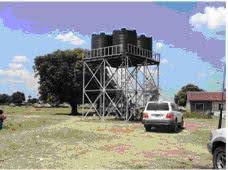Impacts of water crisis on construction companies especially in the Dry season?
Water scarcity significantly impacts Uganda’s construction industry, especially during the dry season. Construction activities heavily depend on a consistent water supply for tasks such as mixing concrete, curing, and site preparation. When water becomes scarce, these operations face delays, increased costs, and compromised quality.
Operational Delays and Increased Costs
A notable example occurred in 2019 during the construction of houses for landslide victims in Bulambuli District. The project experienced delays due to a shortage of water, as the initial phase relied on local sources that proved insufficient. This necessitated the drilling of additional boreholes by the National Water and Sewerage Corporation (NWSC) to meet the construction’s water demands. Such interventions often lead to increased project costs and extended timelines.
Impact on Urban Construction
In urban areas like Luwero Town Council, water crises have been attributed to intermittent power supply affecting water pumps. In September 2023, residents faced a week-long water shortage due to inconsistent electricity, which hindered water distribution. Construction projects in such areas are forced to halt or seek alternative, often more expensive, water sources, thereby escalating operational costs.
Challenges in Maintaining Construction Standards
Water scarcity can compromise construction quality. Insufficient water for mixing and curing concrete can lead to structural weaknesses. Additionally, sourcing water from distant locations increases the risk of contamination, further affecting material integrity. These challenges necessitate stringent quality control measures, which can be both time-consuming and costly.
Mitigation Strategies
To address these challenges, construction stakeholders in Uganda are adopting several strategies:
- Rainwater Harvesting: Implementing systems to collect and store rainwater during wetter periods for use during dry spells.
- Efficient Water Management: Utilizing water-saving technologies and practices to minimize wastage on construction sites.
- Alternative Water Sources: Drilling boreholes or collaborating with local authorities to ensure a reliable water supply.
- Scheduling Flexibility: Planning construction activities around seasonal water availability to reduce the impact of shortages.
By proactively implementing these measures, the construction industry in Uganda can better navigate the challenges posed by water crises, ensuring project continuity and structural integrity.
Ways that the government or construction companies can put up to overcome this crisis?
To overcome the water crisis affecting Uganda’s construction industry, both the government and construction companies can implement strategic interventions. Here are some key solutions:
Government Interventions
- Investment in Water Infrastructure:
- Expand and improve water supply networks, especially in urban areas, to ensure consistent access.
- Construct more dams, reservoirs, and water treatment plants to store and purify water for construction and other uses.
- Regulation and Policy Development:
- Enforce policies that mandate efficient water use in construction projects.
- Introduce incentives (such as tax reductions) for companies that adopt water-saving technologies.
- Promotion of Rainwater Harvesting:
- Encourage the use of rainwater harvesting systems in both urban and rural areas.
- Support the installation of large-scale water storage tanks at construction sites.
- Drilling More Boreholes and Wells:
- Increase the number of boreholes and wells in water-scarce regions to ensure a steady supply.
- Provide subsidies or funding to private companies for borehole drilling.
- Enhancing Climate Change Adaptation Measures:
- Invest in reforestation and wetland conservation projects to improve water retention in the environment.
- Develop a national water crisis response strategy that prioritizes high-demand sectors like construction.
CONSTRUCTION COMPANY STRATEGIES
- Water Recycling and Reuse
- Construction companies should implement water recycling techniques to reduce dependence on fresh water.
- Methods include:
- Capturing and reusing wastewater from site activities (e.g., washing and curing).
- Using sedimentation tanks to remove debris from used water before reuse.
- Adopting low-water construction technologies such as foam concrete and geopolymer cement.
Example:
In South Africa, major construction firms recycle wastewater for concrete mixing. Uganda’s companies can adopt similar strategies.
- Adoption of Dry Construction Methods
- Traditional wet construction techniques (e.g., concrete mixing) require large amounts of water.
- Alternative dry methods can help reduce water consumption:
- Prefabricated building materials (e.g., pre-made concrete slabs, steel structures).
- Drywall partitioning instead of cement-based walls.
- Interlocking bricks, which require little or no mortar.
Example:
In Rwanda, interlocking bricks have been used to reduce water usage in public housing projects. Uganda can encourage similar innovations.
- Large-Scale Water Storage at Construction Sites
- Construction companies should invest in large water storage facilities to:
- Collect and store water during periods of supply.
- Reduce reliance on external sources during shortages.
- Minimize delays caused by intermittent supply.
Implementation:
- Install underground water tanks at construction sites.
- Use high-capacity bowsers (water trucks) to transport water when necessary.
- Encourage water budgeting, ensuring water is only used when absolutely needed.
- Collaboration with Water Supply Agencies
- Construction companies should establish formal partnerships with NWSC and private water suppliers to ensure a reliable water source.
- Strategies include:
- Signing bulk water supply contracts to guarantee access at stable rates.
- Working with local water boards to secure priority access.
- Investing in private water trucking services for emergency supply.
Example:
Chinese construction firms in Uganda often source water from private suppliers to avoid shortages. Ugandan firms can follow suit by securing reliable supply agreements.
- Seasonal Planning and Project Scheduling
- Construction firms should plan water-intensive activities around seasonal water availability.
- Strategies include:
- Scheduling major concrete works during rainy seasons to maximize water availability.
- Using weather forecasts to plan project phases accordingly.
- Adjusting work schedules during peak dry months to prioritize less water-intensive tasks.
Example:
In Ethiopia, government-led infrastructure projects adjust their timelines based on seasonal water availability. Ugandan construction firms should adopt a similar approach.

Here is an image of a construction site in Uganda featuring a rainwater harvesting system, storage tanks, and workers using stored water for mixing concrete. This visually represents one of the key solutions to mitigating the water crisis in the construction industry.

Here is another image showing a construction site in Uganda using water-efficient techniques, including interlocking bricks that require minimal water and a borehole for limited construction needs.

CONCLUSION
By combining government interventions (such as expanding water infrastructure and enforcing conservation policies) with construction company strategies (such as water recycling and dry construction methods), Uganda can reduce the impact of water shortages on the construction industry.
Immediate actions, such as increasing boreholes and enforcing rainwater harvesting, should be prioritized, while long-term investments in climate adaptation and water management will ensure sustainable construction practices in the future.
By adopting these measures, Uganda’s construction industry can remain resilient and efficient, even during severe water crisis


